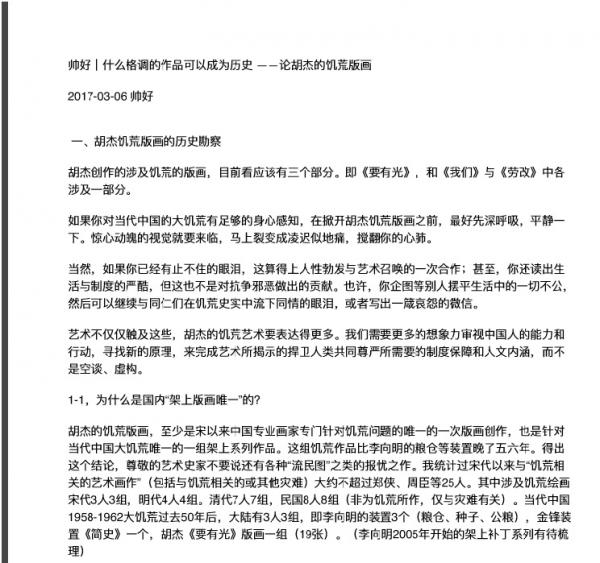
What Kind of Art Work Can Turn into an Instant Classic - On Hu Jie 's Famine Themed Woodblock Prints 2017-03-06 Shui Hao A Historical Survey of Hu Jie 's Renowned Woodblock Printing on the Famine Theme The famine related thematic woodblock printing created by Hu Jie herewith consists of three major sections: "Let There be Light ", "We" and " Reform Through Labor " respectively. If you have been unaware of the magnitude scales of the Great Famine perceptually in contemporary China, it would be advisable to take a deep breath to calm down yourself before unfolding this album of the famine themed Prints by Hu Jie,for the ensuing visual sensation would engulf you instantly with excruciating and gut-wrenching experience. Undoubtedly, if your heart has already started racing uncontrollably at merely browsing the work, it is a sign of art echoing the call of your humanity reawakened. Furthermore, if you also sensed the crudity of life and of the social system, it still cannot count as your contribution to the fight against evil. Perhaps you still await others to eliminate all the injustice in life so that you might be able to entertain the liberty to shed tears with your colleagues on the famine theme or compose a message on Wechat. Art, not only results in those effects. Hu Jie's art of famine, the thematic woodcut, aims to express more. We need more imagination to examine Chinese's ability to act, to find a new truth, to comprehend the art revealed by the sense of common human dignity which must depend on the underlying system to protect its security and content. No empty talk or fiction allowed. 1-1, Why Is Hu Jie’s Artwork the “Only Woodcut Print Present" in China? Hu Jie's famine thematic engraving, as early as since the Song Dynasty, is of the unique Chinese art form by professional painter’s work dedicated to the famine problem, the solo print creation shadowing the contemporary Chinese famine. By comparison, this series of famine works was produced five or six years later than Li Xiang Ming’s “Granary Theme” work. In light of this conclusion, our respectable art historians would say that there existed a variety of "normadic arts" like this in light of tragic periods in China. I have surveyed the history of the "famine themed art paintings" (including famine-related or other disasters) since the Song dynasty. They won’t exceed twenty five artists including Zhou Chen and Zhang Shuang, etc., in total counting. Among those, involving the famine painting of the Song Dynasty is of Three or Three Groups; the Ming Dynasty, of Four or Four Groups; of Seven or Seven Groups, in the Qing Dynasty; of Eight or Eight Groups, (for the famine, only related to the disaster) in the Republic of China era. In contemporary China of 1958-1962, the Great Famine, 50 years later, there had been Three or Three Groups, namely, Li Xiangming's Trilogy (Granary, Seed, Public Food), Jin Feng’s "Simplified History", Hu Jie’s "The Light" print group (19 pieces). (Li Xiangming’s the “Shelf Patch” series started in 2005 to be yet counted.) 
All the artworks up to 1949, including those produced by officials and the local gentry organization under titles of "Letter Engraved", "Propaganda Engraved" and "Books Engraved", professional painters and famine-related works of art are of almost "zero". This is no glory of Chinese art history at all, rather, an indication of the whole Chinese artist's frustration and also shamefulness over this long period. (Referencing Shui Hao’s 《Aesthetics of Community》and《Studies on Artworks Since the Song Dynasty》). In this famine related history over a thousand year’s period since the Song Dynasty, China experienced multitude of famine disasters. Up to the year 1962, there were a total of three thousand two hundred and fifty times approximately. Even for the past two hundred years, of the Qing Empire of 1810 to 1888, along with the destruction of the Tai Ping Heavenly Civil War, there were famine related deaths of six thousand two hundred million in those seventy eight years; during the period of the Republic China from 1919 to 1935, with countless warlords fighting civil wars of sixteen years, famine related deaths reached More than eighteen millions of people; from 1958 to 1962, there were overall no major natural disasters or wars, the famine related death toll, however took anywhere from thirty five to thirty seven million population in only a three-year period. Behind these cold indexes, were twenty million of those "statistical lives" silently suffering agonizing death - one of the tragic cruelty still buried in the dust of historic facts till today. The exposition of the famine theme in the form of art is of just a manifestation of the history of famine and scientific historicism, but after careful inventory of their artworks, it is found that the famine theme related is of zero and that the works of contemporary Chinese artists are almost zero. (Contemporary artist Li Xiangming has a lot of works, but it has not yet been sorted out yet.) What led to this? 1-2, Why Art Does Not Pursue the Origin of Demise and Reincarnation of Life Caused by Famine? There had been none of the art on famine theme in contemporary China for the following reasons: First of all, the famine affected victim groups are often of Chinese peasants as the major social class, the class of whose rights and freedom had never been obtained. And further more they never had any Chinese intellectuals as their spokesmen, so the famine related deaths as often repeated disaster were a factual reality resulted in by the dictatorship of the emperors themselves, by their imperial bureaucratic system and by the intellectual community who all of them ignored those tragedies in China’s millennium society and repeatedly had been replenished by generation of generation of peasants’ offsprings due to inaction of their government. Secondly, from the perspective of the life of art itself, collection and display are almost of the major motivation for artifacts to become popular or creative. The Chinese art collection was basically concentrated in the above three imperial groups and the rich. This group did not need to collect the history of these historical famine themed masterpieces, because they themselves were of not among the starvation social classes, and would never deeply experience hunger of death and pain anyway. Their lives and the decision they made, however, constituted the main parts of Chinese social activities which could not be missed.
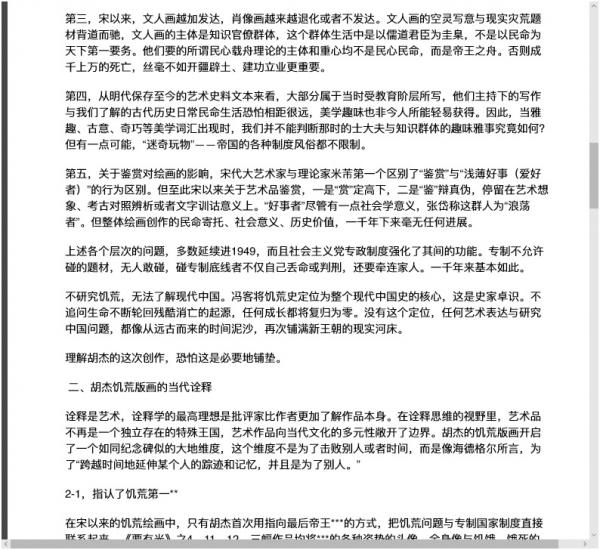
Thirdly, since the Song Dynasty, the more developed the painting artwork, the less developed or underdeveloped the portrait artwork. Painting embodied the work by ethereal freehand while the subject matter of the disaster the reality of social life. The main body of the painting was by the bureaucratic groups following Confucianism as their ideals under heaven while ignoring the representation of the reality of social life as their mission. On the one hand, they endorsed the theory that the popularity or unpopularity of a government could sink the ship of a whole country, on the other hand, they worshiped the authority much more than cared about the majority’s desires. So much so evidently, millions of deaths due to famine disasters played a much less role than acquiring territories to build up fames for the rulers of the country. Fourthly, the preservation of the artwork in history from the Ming Dynasty down to present, the majority of them belongs to the work by the educated classes. The life reflected in the artwork at their times were probably much different than what we know life today, neither can aesthetic interest be easily appreciated by our contemporaries. Therefore, when some aesthetic terms were used, it is no wonder that our total ignorance of their tastes and interest could well come to light. It is possible, however, "with various fascinated plaything" – which the imperial bureaucracy of any systems would not restrain. Fifthly, on the impact of appreciation on painting, the Song Dynasty artists and theorists Mi Fu distinguished between "appreciation" and "shallowly favor (lovers)" for the first time in Chinese art history. Nevertheless, tracing down history ever from Song Dynasty on the appreciation of works of art, there had been only two standards: level of taste and genuine or fake stalling in the art of imagination, archaeological analysis or syntax studies. Despite the minimum of sociological significance, Zhang Dai refers this group as "wanderer". Overall, the famine theme related paintings over the millennium years had been null in existence in terms of creation of sustenance, of social significance and of historical values. Many of the above-mentioned problems persisted in majority into the 1949 while the socialist party's dictatorship system got them strengthened even more of their functions. Autocratic does not allow touching certain subject matter. Whoever dare to break taboos either got themselves sentenced or losing their lives even implicating their family members – nothing changed over a thousand years onward in China. Without studying the famine, no understanding of modern China is possible. Feng Ke, a Chinese historican specialized in famine subject area, regards the famine studies as the core piece of understanding the whole modern China’s history, which reflected key insights of those expert Chinese historians. No inquiring into the tragic fate in the reincarnation of the origin of famine related deaths, any progress would return to null eventually. Without this positioning of the famine, any artistic expression and study of Chinese problems would be like the sediment of washed sand from ancient times once again only to fill the river bed of another China’s new dynasty. To comprehend the creation of this edifice by Hu Jie’s of his artwork, I deem the above as a necessary bedding. I.The contemporary interpretation of Hu Jie 's famine prints Hermeneutical interpretation is of the nature of art whose ideal is that its critics perceive more in the artwork itself than the creator him or herself. Through interpretation, the vision of thinking of art is of no longer an isolated existent art kingdom with its particular properties, art works are expanding its boson to embrace the whole horizon – a dimension of our modernization in its related culture. Hu Jie’s famine themed prints is as if establishing a monument - a entirely new dimension that was not intended to beat the time or their enemy, as Martin Heidegger once said, it exists as "trailing on someone’s memory and extending his time, and for the sake of others. 2-1, Identified the Primary Cause of Famine In the famine painting since the Song Dynasty, only Hu Jieji pointed squarely to the last emperor with the famine problem directly linking it to the authoritarian state system. "Let There Be Light" of the 4,11,12, of these three pieces of work will be *** of the various posture of the head, the whole body like hunger, starved to death in the midst of the painting, it is not compromising to specify who is the first cause of China’s famine disaster. In this aspect, it is similar to the handling by the Gao Brothers in their works. 
The existing famine data can show that during the Great Famine of 1958 to 1962, the prerequisite of the party-led aesthetic world was that any rebellion would be punctually punishable according to the party's interpretation and the commands. During this period, even remaining silent in China’s society is of speaking with volume. Party officials, especially the administrators of the local ruling authority, had the hobby of the art collection to promote creation of art, the aesthetic standards of officials becoming the whole party’s aesthetic standards purely for fun. This party's standard of esthetics is of not only the taste of ***, is of a group of members in the leadership, through the organization of their meetings to promote this standard in the name of people in order to maintain the ruling of the majority. So majority of painters are beneficiaries at the expense of the party for receiving free room and board while travelling north to south producing artworks. But today's question is, what a stone heart one needed to have facing hungry and deaths everywhere while maintaining indifferent, and what caused this indifference in art workers. A more prevalent explanation to this phenomena is that artists faked sleeping then. More questions would ensue, for example, what would happen if then the dead were your parents? The answer is invalid obviously. Finally what is the background supporting the “pretending to sleep” excuse? 2-2, Pointing to the Society’s Corrupted Management System Causing the Famine Disaster Also the work points to the way how D government to rule the country, such as the village administrative system, "Let There Be Light" of the 7, 13. (The child's body had long been decomposed but the father had also long been indifferent to any personal tragedy even death, only holding his son’s poorly covered tiny body still showing protruding bones, while the loud speaker in village was majestically raising its volume in full operation – a sign of the village management function in the era of the Great Famine).Carrying out similar function is of the city and county judicial systems, "Let There Be Light" of 9 (to combat so called “food speculation”, was then the focus of the local law in the Great Famine era, the law target was to prevent the famine victims to flee out of the village begging, so as to make starving to death came hidden without anyone else’s knowledge, otherwise how could there be all kinds of weird restrictions to stop those starved villagers to flee?) Furthermore, the beneficiaries of the Great Famine were the Propaganda and Culture Departments of the government in the social system. As shown by "There Be Light" of the 17 (the famous headlines on production per “mu” of 36900 Chinese Unit and the hungry, the great leader waving hands to his people were like a never eroding image deeply etching in China’s history. In fact, those profited systems not only failed to rescue any victim, on the contrary, they in fact more involved in covering up the disaster, with the cooperation of nepotism of Chinese painter 's groups). Yet, another intellectual group who lost favor with authorities had to perform hard physical labor to “correct” themselves reflected in Sec. 2,3 etc. Within this group, not everyone was agnostic to the authorizes, on the contrary, due to colleagues’ setup in internal struggle vying to please authorities they ended up losing basic rights in life. When this group had the chance to emerge again from past suppression, they either concentrated solely on their own suffering or joined the chorus of authorizes’ deceiving explanation on the Great Famine ever again. On the other hand, the famine victims were numbed with dose of China’s ancient poem and lyrics. In the past studies of famine history, war, natural disaster, corrupt politics were always the main causes of famine. The works of art reflected the tragic situation of the famine as well as the savageness and brutality of human nature facing famine, but in 1958 to 1962, the Great Chinese Famine occurred without either war or nature’s interference which were largely absent. Corruption of politics was, if not the only cause, must be the main cause. In addition to beheading, starving to death, fleeing, etc, were there any other means to survive? As a result of the my long time studies of the famine problems, each time when facing the history of the famine or of artworks, I had the apprehension lingering in my mind. Except the accumulation of wealth with artworks and fulfilling the fancy and interest, in terms of historical mission to society, artwork has really nothing to do with it at all? If so, why artwork became the evidence exposing collapse of dynasty, of the corruption of bureaucrats, of the aesthetic overuse showing affluent life styles. These stolen goods underlining lost life while turning into expensive properties and collected by the corrupted bureaucrats, none of which had the theme of helping the famine victims. Confronted with the crude reality of social life, the historic truth, I deem it inappropriate not to question the relationship between artistic creation, aesthetic value and the "legitimate regime" definitely bearing some kind of causal connection which even God would not forgive. Bourdieu said: "Art is of the main field of social negation." This view is fundamentally none existent in the study of the relationship between Chinese painting and the famine. 2-3, Enlightenment of Religion and Consciousness for the First time The content of Hu Jie famine prints also touches on religion itself, such as "Labor Reform" of the 4. After burial of colleagues’ bodies, one might be granted food, a dream like in Church carrying out the funeral. "Let There Be Light" of the 15 is a vivid description similar to the Holy Spirit descending to China full of sadness since who were helpless. Even religion existed legally in China in this iron clad society, as in such disastrous period of the "Ding Wu Extremely Shortage", the church could at least offer food relief to the victims under the Qing Dynasty. At this juncture of China’s history, everybody submits obedience to an invisible hand under its command. It is not that Chinese were not blessed by the grace of God, it is Chinese themselves’ rejection of God's revelation. In this way, Chinese replaced their traditional morality value theories with the so called "class division" of socialism. Although in our modernity, humanism was put in the place of God, China’s socialism also overrode the latter. Thus as God, traditional moral theories or humanism were none existent, what else could the victims of the Great Famine do facing starvation to death? Nothing could underline their spiritual support for those victims - Hu Jie’s interpretation of his reflect on the historic event was both rich and profound in depth indeed. 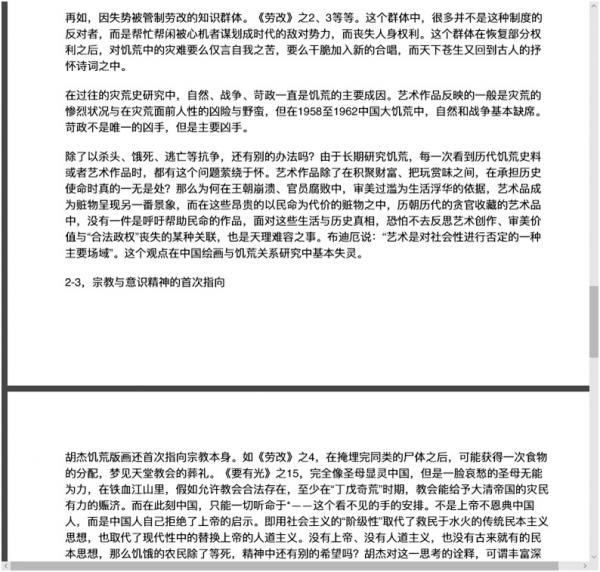
Furthmore Hu Jie’s artwork also questioned the relationship among masses, famine event and social disaster. This is the version of the painting representing the evil of mediocracy after revolution, in "We" of the 3,4,6. It is not the exposure by painting of the emperor's new cloth, rather, it is to show the fast bond to be deep-rooted between the evil of mediocracy and the modern state bureaucratic order in people’s habit, echoing the calling between fascism and socialism. While the people of freedom from the era of "Locke to Lincoln", or of "from Rousseau to Roosevelt", finally turned to "constitutional rule", under the Party system, its people were led to two directions. One direction of Hitler of Germany which was based on personal worship, and the other of a utopian China of communism. What role do we play in between? And why did we play such a role in them? The rule that points to modernity or the rule of the state system itself was of the potential brainwashing of consciousness, which neutralized humanity, responsibility and social goodness. Otherwise how would there be so many icons of "artists" joined the "singing death" chorus while ignored the obviously devastated victims with their works portraying million of masses happy lives everywhere. 2-4, Modernity and Paradoxical Expression of Famine Massacre The creativity embodied by Hu Jie prints lies in the connection between the modernity and famine slaughtered masses and inquired the paradox of modernity itself, which is pretty unique in the contemporary Chinese art. "We" of the 2,6; "to light" of the 3,8; "labor reform" of the 1, these three sets of artworks expressed the feature of emergence of modernity: such as sections of a type of machines, railroad and concentration camp labor reform and iron pick tools and so on. The primal motivation of human is to "do good and avoid evil" which is a born impulse well before one enters his or her social community. But in the period of famine, the whole social system was dominated by the socialist bureaucratic government under which the whole social apparatus was coerced into a society of ruthless machine obedient only to directives non-existence of morality, of justice, and of responsibility. We encountered in the famine historic data many calls from conscientious, brave individuals and peasants for help, for humanity support etc. but those ended up either getting executed, or tortured. The standard to social machine manufacturing is the opposite of humanity, as shown by "We" in the 2 with that rope being tied around the neck by a machine. The executor taking the rope for the execution did not think that his action had anything to do with brutality while tightening the rope buckle gradually, with spectators stood watching speechless. They were all carrying out a command from above - this executed was nothing short of "public enemy". If we were there present in history, you might agree that the hatred of the enemy was of certainly not to express one’s sympathy. 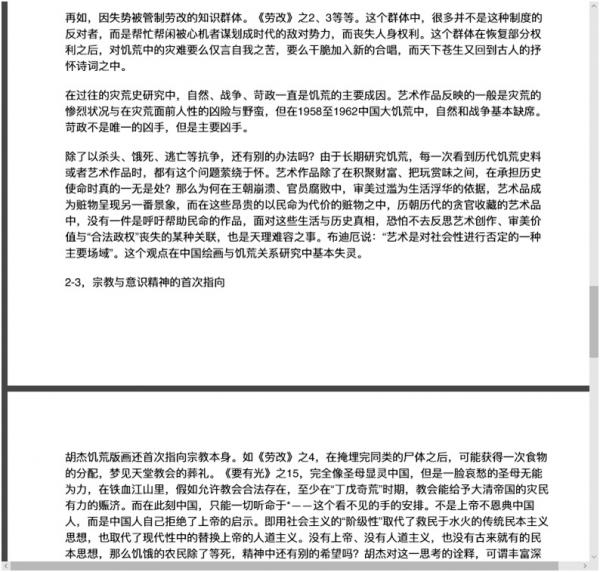
In the same way, the railroads were
used to facilitate convenience in people’s livelihood in modernity, but the
actual history of famine in China showed that in the years of 1958-1962, these
railroads mainly used to transport from hungry rural villages robbed rations
levied from the starved masses. At that time, Sichuan, Guizhou, Anhui,
Shandong, Henan and other central provinces suffering from mass starvation all
transported a great amount of grain to the less needed cosmopolitan areas, even
to the neighboring socialist countries. The cause leading to the collection of
grain to become a national disaster was of the source of the local Guangdong provincial party providing anti-misinformation
on the production of grain to the central government. This information after
escalating to all levels over the whole country, led to the famine slaughtering
in the agricultural areas 10-fold more tragic than before. The railway line at
this time became, instead of being a life saving line, but the death line in
reality. Of course, modernity in the authoritarian
state also reflected in a web of authoritarian political branch organizations deep
into the level of countryside which was like the brain affecting each cell of
the body as well. This organized society did not recognize any right to the
commoners who were of being nothing but slaves laboring for others being the
only right for them. Hu Jie prints foreshadowed this everywhere. When I put
part of the painting in class and uploaded to my blog for lectures, someone
commented that Hu Jie prints implied despair.... I do not agree with this opinion. In
fact, from a different perception, Hu Jie prints carried a profound hope from
the apparent atmosphere of despair. It is this hope or compassion that evokes
love and with love it brings up the ability to act. This vital force to act
signifies that even in the era of a harsh ban on the studies relating to famine
disaster and massacre and of the world being so confused and uncertain at the
same time, there are still individuals persistently moving forward in spite of
the hardship. The belief originated not from rational or theory, or from concepts
and guidance. It is of an individual conscience, of trust of freedom by a
twinkle of enlightenment and revelation of repressed religion - this potential lighting
is the most enduring style of Hu Jie’s artwork. 2016 1 draft, 2017 3 revision
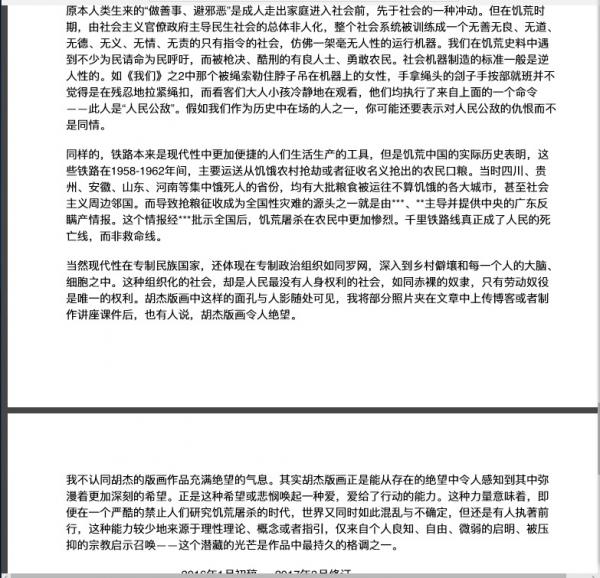
|
